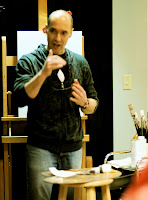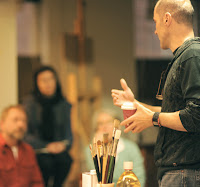
Saturday, November 20, 2010
Wednesday, November 10, 2010
Student Life: Julie, The new kid in school

Saturday Life drawing classes are a hit!
Our new Saturday morning figure drawing class has been so popular that we are adding an afternoon class to our schedule. Class will be mornings 10 - 1 and afternoons 2 - 5. Students will continue working to improve the beginning stages of construction, concentrating on accurately capturing gesture, proportion and body type. Some poses will be extended this session so that some students will be given the opportunity to work longer on some of their drawings. These 8 week sessions will emphasize proficiency in using our step-by-step method beginning with a basic block in, developing the figures specific contour and shadow line and then advancing to beginning rendering of form. Classes will consist of one three hour pose with some continuing for additional weeks. Students will receive individual attention and work at their own pace. New students at all skill levels are welcome. Cost is $300. Space is limited, we have lots of students already registered so call or email immediately to register.
Annual Art Exhibit and Open House
Please join us for our first annual Art Exhibit/Open House at the Academy. This large exhibit will feature the drawings and paintings of our students and instructors. We have been hard at work preparing for this show. We will be displaying works from plaster casts, still life and figure work. Come for a visit, learn about our program and meet some of our dedicated students. If you are interested in taking classes full or part time you can take this opportunity to have a tour of the school and ask any questions you might have. This is a great way to really understand the program and see the results you can achieve.
Our students come to us with a variety of previous art experience, some have been artists for a while and others are complete beginners. What all students have in common is that they are more skilled at drawing and painting because of their studies. You can master the skills of drawing and painting by enrolling in our ongoing classes. If you are unable to attend the open house and would like a tour of the studio call (617)426-3006 or send an email to ara_boston@academyofrealistart.com.
Sunday, August 29, 2010
Ecorche Workshop: Week 2
Throughout the two weeks Andy gave some great lectures on muscles, bones and facial features.
It was hard to say to goodbye to Andy, he was a great instructor and a lot of fun to have around. When he's back home in California we hope he remembers the beer, oysters and good laughs we had. We're going to try and schedule him to come back! It was a great 2 weeks.


Ecorche Workshop : Week 1
Ecorche Workshop: Second half of week 1

Saturday, August 21, 2010
Ecorche Workshop: Day 2

Friday, August 20, 2010
Saturday Classes
Life Drawing Class
Saturday 10 a.m. - 1 p.m.
Begins September 25th
This 8 week course will address the early stages of figure drawing and it's challenges. Working from the nude model, students will use a step-by-step system that stresses proportion, contour and shadow line. Students will draw from 3 hour poses. All levels are welcome. The cost is $300. Register now for this course! It will be taught by ARA instructor Emmy De Musis. Her beautiful figure work can be seen in the Student Gallery on our website.
Our students have been producing great work. I'm very proud of all of you. If you just can't get enough academy info be sure to check out our blog at http://araboston.blogspot.com/

Tuesday, August 17, 2010
Ecorche Workshop: Day 1

Wednesday, June 9, 2010
Head Ecorche at Academy of Realist Art
Here are a few images from his previous workshops:
To learn more about Mr. Ameral and his Anatomy/Ecorche teaching please visit his website: http://ameralart.com/
Registration for the workshop must be submitted by July 20th. To sign up for or receive more information about the workshop notify the Academy of Realist Art Boston. ara_boston@academyofrealistart.com
Monday, May 17, 2010
Sunday, April 25, 2010
Brian's Bargue Line Drawing
During the last figure drawing session at the
Through methodical study, Brian developed a list of 21 concepts that he found consistently repeated in all of the Bargue line drawings from the book. This list contained observations about cast shadows, contour lines, interior form lines, line characteristics, and drawing procedures.
Brian was moderately general about the anatomical forms he drew – only showing the major forms. He tried to minimize the number of lines used by emphasizing longer flowing lines. This effective self directed study by Brian netted him a beautiful drawing and reinforced ideas about line that he can use for all of his future drawings.

Sunday, April 18, 2010
Materials Used by the ARA Boston
For Bargue drawings students use graphite pencil, Mars-Staedler being the most popular brand. The finished drawings are all done on the light grey version of the Stonehenge paper.
For our Figure Drawings we use carbon pencil (mainly Wolfe's Brand,) on Arches 140lb cold pressed watercolor paper. Some of the students have experimented with different types of paper like Artistico, Sommerset, or FA5, but the Arches is still the most commonly used.
For cast drawings we are using non-renewable materials. We draw on Fabriano's Roma paper, which is only printed in limited quantities. The drawings are done with Fusian Nitram Charcoal, a brand of charcoal now discontinued. We have a small supply of each Roma paper and Nitram charcoal so we aren't too worried about the shortages yet. Soon enough though we'll be forced to come up with an alternative. Any suggestions out there in internetland?
Along with these materials we also use kneaded erasers, knitting needles, plumb lines, mirrors, and black mirrors (glass from welder's masks.)
Garrett Vitanza Joins the ARA Boston

Garrett Vitanza is now a part time figure drawing instructor at the ARA in Boston. One day a week Garrett joins us to impart his knowledge of figure drawing acquired over years of study and practice.
Garrett says he first started drawing at the age of five. By the age of 13 he was taking his creations more seriously, drawing in a more recognizable fashion, and working towards building a career in the fine arts.
He began attending the ARA Toronto at the age of 17, and after graduation he spent a number of years teaching a variety of classes from portraiture to red chalk. Now he is settling down in Boston and getting a degree from the School of the Museum of Fine Art.
His top five artistic influences include an array of artists from realists to impressionists: Rembrandt, Goya, Van Gogh, Cezanne, and any early Netherlands artist around the turn of the 15th century. Some of his favorite contemporary artists are Lucian Freud, Yuqi Wang, and Francis Bacon.
If he had to lump his work into one descriptive category (which was required of him for this interview,) he would consider his work to be 'figurative in relation to narrative.' To see more of his work one can visit http://garrettvitanzaart.blogspot.com/
Thursday, March 25, 2010
Hand Lecture
Students at the Academy spent a week learning about the anatomy of the hand and foot. Lectures were packed with information about bones and muscles along with an analysis of morphological anatomy and some insights on constructive drawing principles. We looked at old master paintings and drawings to find evidence of what we learned. Examining works by Michelangelo, Andrea del Sarto, Raphael, Albrecht Durer and others we saw how they masterfully utilized a hierarchy of principles to beautifully render hands and feet.
One lesson that was learned was about the changing appearance of each section of the fingers. The first section closest to the knuckles has a rounded appearance, the center section a more rectangular block-like shape, culminating in the wedge-like shape of the end of the finger. This is clearly seen in this drawing by Albrecht Durer.

Monday, March 22, 2010
John Currin Comes to Boston


Tuesday, March 9, 2010
Materials Lecture


Tuesday, March 2, 2010
Juan's Portrait Demo

- He begins the painting process by blocking in the portrait with thinned down Burnt Umber.
- He continues to use the thin Burnt Umber mixed with black to block in the shadow shapes.
- Next he blocks in the darkest parts of the shirt until all of the shadow shapes have been described.
- Then with gold and grey colors he blocks in all of the mid-tones.
- Then a reddish midtone for all of the warm parts: nose, cheeks, etc.
- He roughly blocks in the darker lights as well.
- He advises not to use thicker paint when you're still trying to establish the drawing of the portrait.
- Finally thicker paint is applied to finish off each of forms of the face: mouth, nose, eyes, cheek, forehead, ear.

Wednesday, January 20, 2010
Demonstration Pieces
Figure Painting in the New Year
 Fernando Freitas is the director and senior instructor at the Academy of Realist Art in Toronto and has been working to inspire artists of all ages for the past 15 years. The Boston school always enjoys Fernando's visits because we get a chance to hear his different perspective on the art world and get a taste for his alternative sense of humor.
Fernando Freitas is the director and senior instructor at the Academy of Realist Art in Toronto and has been working to inspire artists of all ages for the past 15 years. The Boston school always enjoys Fernando's visits because we get a chance to hear his different perspective on the art world and get a taste for his alternative sense of humor.



